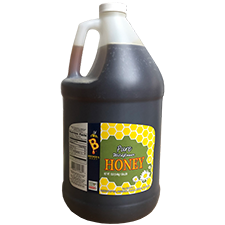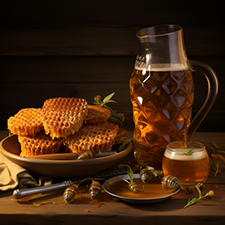Honey, Beer, and the Art of Buzzworthy Brewing
Posted by Matteo Lahm on 26th Feb 2024
Honey in beer making? You bet your sweet bumblebee! This versatile carbohydrate is a thrifty and widely used sidekick for craft beer professionals and home brewers alike. It's not only a great way to up your ABV, it delivers a list of sensory attributes to diverse beer styles that you cannot really get from anything else.
Using honey for fermentation is nothing new. The oldest record is in China around 6500 BC. But for the vast majority of its history, it was used to make what we now call mead. Now that we are enjoying the fruits of our ancestors' labor in the 21st century, there is a lot of room to carefully incorporate it into your beer making process with stellar results.

For instance, honey can make your summer ales and lagers more crushable by lightening the body. It can add a complex flavor profile to your IPAs and sours, thanks to its unique carbohydrate and acid composition. It can even be used as a priming sugar to impart a unique mouthfeel and perception of sweetness. And let's not forget about adding a trademark sweetness to holiday beers and pastry stouts.
But before you start pouring honey into your brew like it's a cup of tea, let's talk about how to use it effectively. The versatility of honey in brewing depends on two key factors: how much honey is used and where it's added in the brewing process.
First, let's understand honey as a raw ingredient. Honey comes from bees, and a bee's diet influences the flavor, aroma, and color of the honey. Some honeys are sweet, while others can be bitter, earthy, or even floral. These flavor attributes can come through in your beer, so it's important to taste the honey you plan to brew with beforehand.
Honey's main sensory attributes, flavor and aroma, are derived from the carbohydrates and acids naturally found in it. Honey is composed of more than 20 different carbohydrates, which make up 99% of its solids and are about 95% fermentable. Honey's acid load plays a significant role in its sensory characteristics, especially gluconic acid, which imparts a sweet taste that turns slightly acidic and can enhance the flavors of other ingredients in your beer.
Now, let's talk about how to use honey in your brewing process. If you want to capitalize on honey's complex composition, but not its sweetness, add it at the end of the boil or at whirlpool. This way, almost all the sugars will ferment out, but some of the honey's aromatics will come through in the finished beer. This also results in a lighter body and drier finish, perfect for easy-drinking session beers.
If you want to add sweetness and aromatics to your beer, add honey at peak fermentation. This ensures the yeast can consume the additional simple sugars without tiring out and stalling fermentation.
But wait, there's more! Honey can also be added post-fermentation to trigger a second fermentation in a barrel or used as a priming sugar. When used to condition, honey adds complexity and produces a tighter foam that imparts an exceptional mouthfeel. It's like the difference between a firm handshake and a limp noodle - you know which one you'd prefer! So, what types of beer benefit from a little honey love? Well, your summer ales and lagers will thank you for the lightness and crushability. Your IPAs and sours will be singing your praises for the complex flavor profile. And your holiday beers and pastry stouts? They'll be as sweet and comforting as a warm hug on a cold winter's night.

But remember, like any good thing, knowledge and moderation are key. Too much honey can overpower the other flavors in your beer. So start small, experiment, and find the perfect balance for your brew. The trick is to add enough honey to impart those exotic characteristics but not so much that it tastes like carbonated mead instead of beer.
Research conducted by the National Honey Board provides insights into how the quantity of honey impacts the taste of beer. Their guidelines suggest that adding honey as 3 to 10 percent of total fermentables results in a delicate, floral flavor and subtle aroma. If you're aiming for a more pronounced honey flavor that can stand up to strong hop flavors, spices, or darker specialty malts, they recommend using honey as 11 to 30 percent of total fermentables. However, if you go above 30 percent, be prepared for a beer where the honey flavor takes center stage, reminiscent of the medieval brew known as "braggot."
Once you have decided on how much honey to include, understand that the more honey you add, the longer it will take for your beer to fully ferment. Here's the scoop: Honey is chock-full of simple sugars, primarily fructose and glucose. While enhancing the flavor and complexity of your beer, honey can add some extra time to your fermentation period because the higher the sugar, the longer the ferment, and it is not linear. The closer you push your yeast to its alcohol threshold, the slower it converts sugars into alcohol.
So there's the buzz on using honey in beer making. It's not just for bears and biscuits anymore. It's for brewers who aren't afraid to experiment and elevate their craft. So go ahead, get your brew on, and let honey be like the secret ingredient in your secret family recipe in crafting the perfect pint. Your taste buds will thank you! Cheers!

